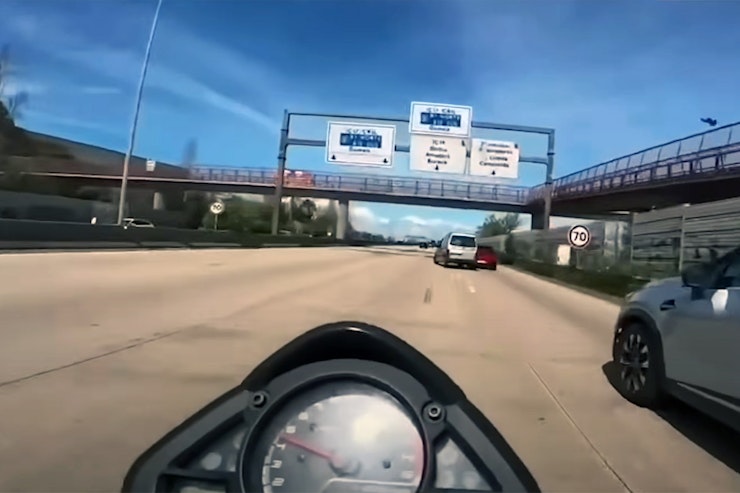Better Riding Advice: Developing Your Motorbike Intuition
By Michael Mann
BikeSocial Managing Editor
19.08.2025
Above: You’ve seen the van pull out and have time to slow but what happens next? The van stops.
In this episode, we’re diving into the concept of motorcycle intuition, or what some call the rider’s sixth sense. It’s that gut feeling, that split-second decision-making ability that can mean the difference between a close call and a crash. I’m joined once again by professional rider coach and ex-MotoGP engineer Mark McVeigh (motorbikecoach.com), who explains what a rider’s intuition is and how it can be developed to make you a better, safer rider.
Read on for a precis of the accompanying video or watch the whole thing here:
Better Riding – Developing Your Motorbike Intuition
How you can develop your motorbike riding intuition and avoid accidents by training your brain.
More skill equals more fun – remember that. This Better Riding series is brought to you in association with Honda Motorcycles UK and MotorbikeCoach.com – a program of self-help videos as well as written content packed full of tips, advice and simple-but-useful exercises designed to help motorcycle riders of all experiences or ability to get more from their riding. It provides expert information and practice drills that help increase rider confidence and machine control skills that supplement traditional post-test training techniques.
What Is Motorbike Intuition?
According to psychologists, the definition of intuition is the ‘ability to understand something instinctively without the need for conscious reasoning’. Neuroscience research backs this up, showing that intuition plays a crucial role in driving decisions - especially in high-risk environments like motorcycling. Furthermore, “Our subconscious brain attempts to use patterns of thinking based on prior experience”, according to Dr Jeremy Sutton, Ph.D, University of Liverpool. Which, according to our own Mark McVeigh translates into motorcycle talk as, “Intuition allows riders to anticipate what other road users might do before they do it. It’s a shortcut to fast, high-quality decisions with minimal cognitive load.”
You’re filtering and up ahead there’s a car-sized gap opened up in the right-hand lane. So what’s the black SUV on the left going to do?
Why does intuition matter to motorcycle riders?
Around half of motorcycle crashes involve another vehicle. The ability to predict driver behaviour, whether it’s a car pulling out unexpectedly or a van changing lanes without warning, is essential for rider safety. Mark adds, “If you expect it to happen, you’ll ride more defensively. You’ll adjust your speed, your lane position, and your awareness.”
If you’re travelling at 60mph and the van pops out from behind the wall into your path, what do you do? Or if you’re following another rider who stops at the roundabout while you’re looking right, what happens 1 second later?
Can You Train Your Sixth Sense?
Absolutely. While intuition is built on experience, it can be hacked and accelerated through structured training. McVeigh’s system, developed over 20 years and used to train over 10,000 riders, is built around three pillars:
Skill – Practicing core riding techniques like emergency braking and cornering.
Craft – Reviewing crash footage and close calls to build hazard perception.
Mind – Developing a defensive mindset and situational awareness.
By simulating common crash scenarios and practicing the correct responses, riders can build muscle memory and instinctive reactions - just like Mr McVeigh did when he trained himself to roll off a bike in case of brake failure when road racing in his native Northern Ireland 30 years ago.
Common Intuition Training Techniques
At Mark’s riding academy based in Australia, riders learn from the mistakes of others, just like pilots do in the aviation industry. Some key lessons include:
You’re invisible: Assume drivers haven’t seen you. Watch their front wheels for movement.
Situational awareness: Predict what drivers around you might do next.
Lane positioning: Choose the safest spot in your lane based on potential hazards.
Group riding: Maintain safe distances and avoid herd mentality.
Filtering: Go slow enough to react if a door opens or a car changes lanes.
Or sometimes it’s as simple as poor road design to target fixation, each scenario offers a valuable lesson in rider awareness and decision-making. When you’re next out riding commentate to yourself – mention all the potential hazards and what your responses are to avoid possible danger. Or, if you have an action camera (here’s a link to our reviews of the most recent 14 options), record your ride and review it afterwards looking at possible areas to improve. And if you’re not sure then ask us over at BikeClub or on our private Facebook Group.
Striving to improve is part of human nature. Whether it’s a passion, a hobby, or even your profession, there’s always a drive to get better. In motorcycling, that pursuit of progress can be the difference between a good ride and a great one - or even between a close call and a safe arrival.
Spotting the oil patch, dodging the pothole, reacting to the unexpected, those moments test the skills you've practiced. And when they pay off, you know the time spent training was worth it. We all want to ride better. And riding better means riding safer.
Better Riding is supported by Honda Motorcycles UK as part of their commitment to rider safety and their goal of achieving zero traffic fatalities involving Honda mobility products by 2050.
